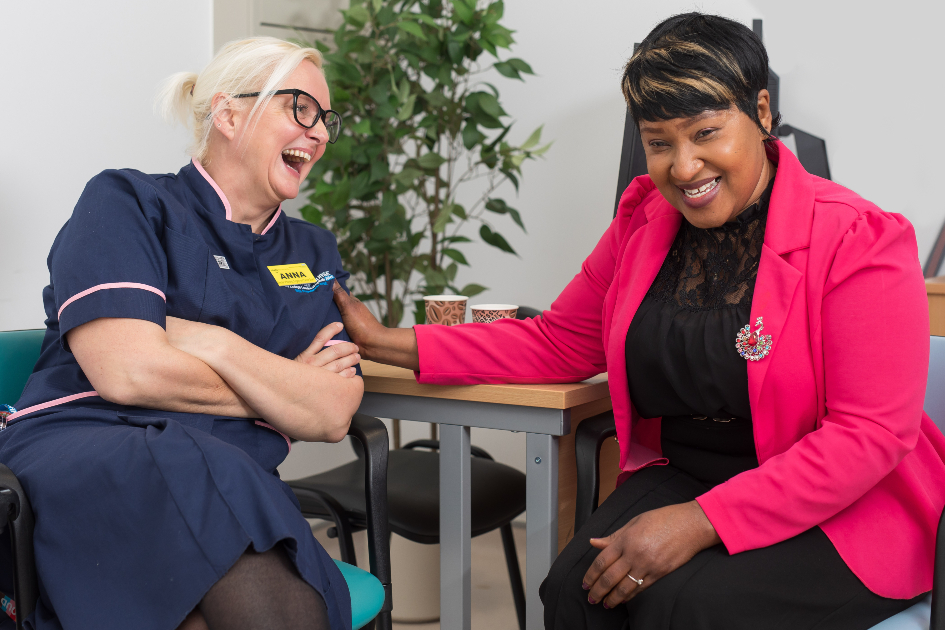Exercising might seem like an enormous challenge for older inpatients recovering from mental ill health…unless it’s something they look forward to
Support workers in south west Scotland are leading a project to promote physical activity so inpatients develop the strength they need to return home. The approach is subtle and fun, with a focus on ability rather than age.
They’re using a programme called Let’s Motivate. Originally designed for care homes, its focus is on motivating and empowering people. But it’s not just about organised activities, patients get involved in all kinds of things including outdoor darts, walking challenges, Tai Chi and much more.
The support workers on Nithsdale Ward in NHS Dumfries and Galloway have had training to help them develop ideas and skills to lead the programme and embed physical exercise as part of daily life there.
Belinda, a band 3 support worker on the ward, says the focus is on getting people moving.
“We’ll say: Let’s make a cup of coffee in the kitchen, and before they realise what they’re doing, patients are on their feet.” Some patients like playing ball games too. According to Belinda it also helps patients grow in confidence.
“When patients say they can’t make themselves a snack because the cupboard is too high, we focus on gradually throwing the ball higher. We throw different size balls at different heights to encourage them to reach higher without even realising they’re doing it. When we point out what they’ve achieved they realise they’ll be alright reaching a higher cupboard when they get home.”
Staff enjoy themselves too. “The patients like that we get involved and it shows we’re not asking them to do anything we wouldn’t do ourselves,” Belinda explains.
It’s a way to get people talking and moving without making a big fuss
The programme is never a chore – who would want that? Fun is the way forward and using equipment that looks like big fly swats so balloons can be bashed about doesn’t really seem like exercise.
Another game involves catching a ball and answering a question – perhaps about the job a patient used to do, or the first Christmas present they can remember.
“We focus on what people want to do or talk about. It’s a way to get people talking and moving without making a big fuss,” says Belinda.
Patient choice
The team look at getting the patients active for around 150 minutes a week, in line with national guidelines on physical activity. But this can be broken down into activities the patients choose to get involved in. So if they have a hobby like gardening, that can be worked in, but they can avoid things they don’t like.
As well as helping patients the programme is enhancing and invigorating support workers. They collaborate closely with the physiotherapy team on strength and balance and other staff on the ward, whatever their role or grade, have been given a responsibility by support workers to encourage participation in the programme too.
“We also talk to relatives, and have put up posters around the ward suggesting family members go for a walk rather than just sitting and chatting when they visit,” explains Belinda.
The link between mental and physical health is clear to see
With an activity room full of equipment such as a sticky ball to throw into a target area, pedometers, Velcro balls and an outdoor darts kit, the team has embedded the culture of movement into the ward.
Initial evaluations have been encouraging and further, long-term evaluation, is being proposed to examine the impact of the exercise sessions across different measures including wellbeing, fatigue levels and length of stay.
“We’re a teaching hospital and students love coming here to see the evidence for themselves,” Belinda says.“The link between mental and physical health is clear to see.”
Talking and walking
Erica Threlkeld is a HCSW on Nithsdale Ward in Midpark Hospital
“Some patients felt anxious about going out so we started with short walks to build up their confidence. Now they ask us if they can go.
“We sometimes take a walk by the Crichton grounds – there’s a beautiful church there which makes it a pleasant stroll.
“Some choose to walk around the building, and for others we take the wheelchair so even if they can’t walk too far, they can still benefit from fresh air and a change of scenery.
“It’s a great chance to spend time with patients. Chit chat while walking feels less strained than when we’re in a clinical environment and I find a bit of humour can go a long way. We also use chair exercises for patients who can’t get out of their chairs easily. We put music on and have some fun.”
Further information
- Find out about joining the RCN Older People's Forum.
- Read about RCN membership for nursing support workers.








